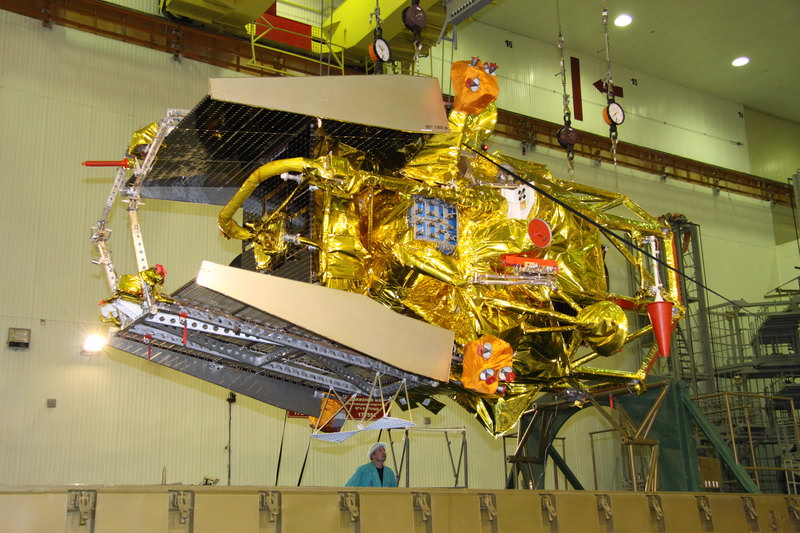

Russia’s Phobos-Grunt sample return spacecraft is uncrated after arriving at the Baikonur Cosmodrome on Oct. 17, 2011. Launch to Mars is scheduled for sometime in November 2011. Folded solar panels and Phobos sample return vehicle at left. Phobos Lander and Yinghou-1 Orbiter at center, right. Credit: Roskosmos.
[/caption]
Barely in the nick of time, Russia’s groundbreaking Phobos-Grunt interplanetary spacecraft to Mars finally arrived on Monday (Oct. 17) at the Baikonur Cosmodrome launch site in Kazakhstan – and today (Oct. 18) an eye-popping collection of great images (see below) was at last published by Roskosmos, the Russian Federal Space Agency.
This first-of-its-kind spaceship is due to blast off quite soon – sometime in the first half of November – although Roskosmos has yet to announce an official launch date and time is running out. The deadline to Mars is Nov. 25.


The photos illustrate the solar panels, landing legs, J-shaped soil sampling tube, Earth return vehicle and descent capsule, star trackers, communications antennae, maneuvering thrusters and more.
Phobos-Grunt was just air shipped from Moscow to Baikonur inside an Antonov An-124-100 “Ruslan” cargo plane operated by “Polyot” airline.
The cargo canister was offloaded and transported by truck to Facility 31. The spacecraft was then placed on a test stand to begin an intense period of final prelaunch payload processing activites to ready the probe for launch.
The Zenit-2SB booster rocket also recently arrived at Baikonur for ongoing prelaunch processing at nearby Building 42.
Russia’s engineers and technicians will have to work diligently in the few weeks remaining in order to complete all preflight activities to achieve a liftoff to the Red Planet before the unforgiving and narrow launch window closes for another 26 months.
Phobos-Grunt is a daring sample return mission whose goal is to retrieve up to 200 grams of soil and rock from the tiny Martian moon Phobos, that will help elucidate the origin and evolution of Phobos, Mars and the Solar System.
Read Ken’s continuing Mars features about Phobos-Grunt, Curiosity and Opportunity starting here:
Phobos-Grunt: The Mission Poster
Daring Russian Sample Return mission to Martian Moon Phobos aims for November Liftoff
Assembling Curiosity’s Rocket to Mars
Encapsulating Curiosity for Martian Flight Test
Dramatic New NASA Animation Depicts Next Mars Rover in Action
Opportunity spotted Exploring vast Endeavour Crater from Mars Orbit
Twin Towers 9/11 Tribute by Opportunity Mars Rover
NASA Robot arrives at ‘New’ Landing Site holding Clues to Ancient Water Flow on Mars
Opportunity Arrives at Huge Martian Crater with Superb Science and Scenic Outlook
Opportunity Snaps Gorgeous Vistas nearing the Foothills of Giant Endeavour Crater
Air travel produces around 2.5% of all global CO2 emissions, and despite decades of effort…
Researchers study enigmatic asteroid Kamo'oalewa, as China’s first asteroid sample return mission moves toward launch.…
In 2007, astronomers discovered the Cosmic Horseshoe, a gravitationally lensed system of galaxies about five-and-a-half…
Venus differs from Earth in many ways including a lack of internal dynamo driving global…
The journey to Mars will subject astronauts to extended periods of exposure to radiation during…
Anthropogenic climate change is creating a vicious circle where rising temperatures are causing glaciers to…